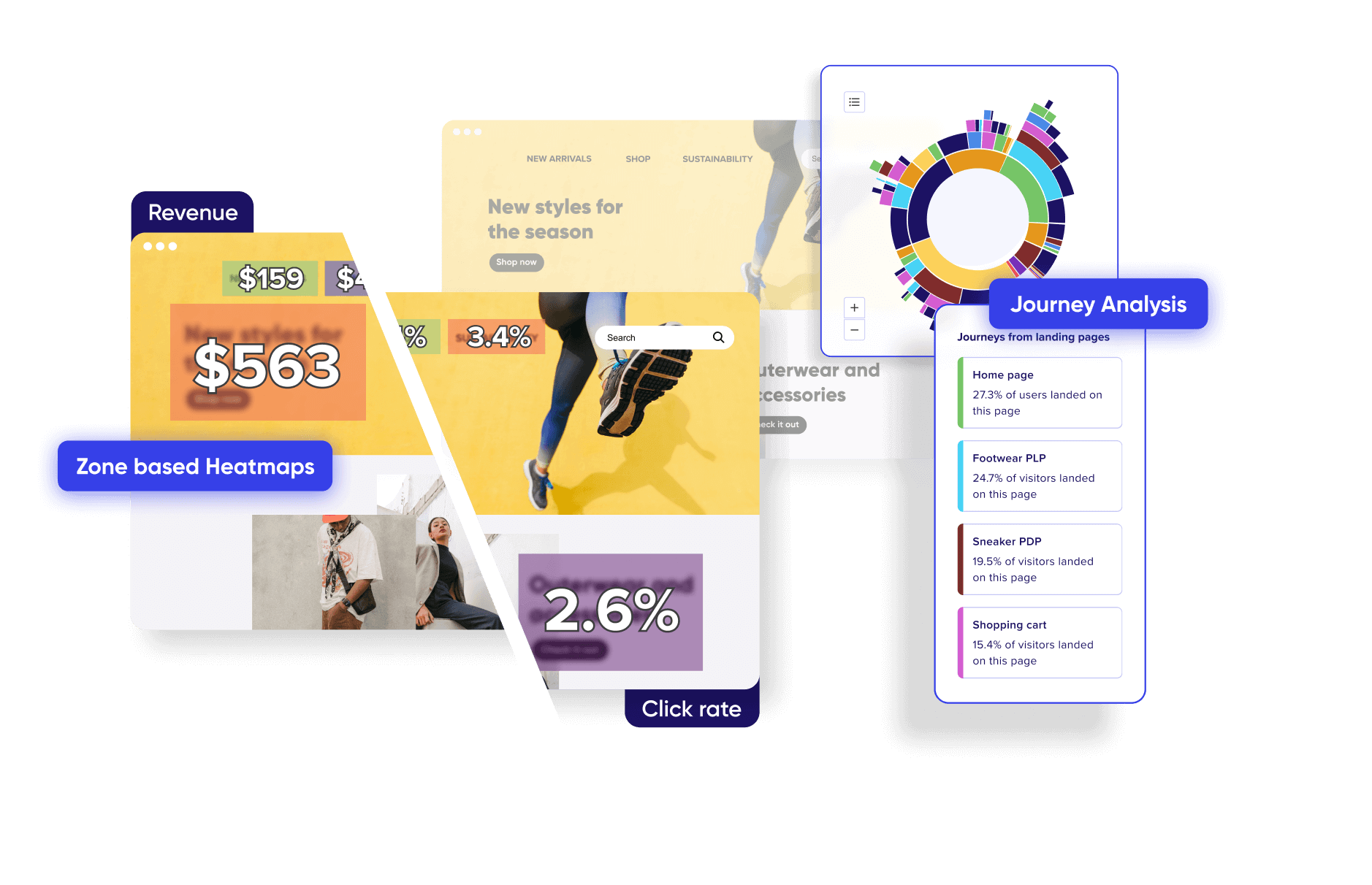
Know what drives engagement and abandonment on your sites and mobile apps.

This approach provides a holistic view of the customer journey data experience, offering insights into customer behavior from the initial interaction through to long-term engagement.
The goal is to provide businesses with a comprehensive understanding of the paths customers take towards conversion, including their interactions with various channels such as websites, mobile apps, physical stores, and more.
This form of data analytics enables businesses to identify key trends, opportunities, and potential issues in the customer journey. By leveraging customer journey analytics, businesses can optimize the customer experience, improve customer satisfaction metrics, and increase conversions.
It’s a strategic approach that aids businesses in understanding the customer’s perspective, refining their marketing strategies, and predicting customer behavior to make informed decisions that enhance the overall customer experience.
Customer Journey Analytics is the process of interpreting the touchpoints a customer has with a company to identify customer needs and predict future interactions. It combines quantitative and qualitative data to analyze customer behaviors and motivations across touchpoints and over time.
This advanced analytics tool allows businesses to visualize the path customers take on their buying journey, from the top of the purchase funnel to the bottom. Customer journey analytics goes beyond data collection.
It involves understanding the data and using it to improve the customer experience. This form of behavioral data analysis allows businesses to understand what motivates their customers, how they interact with their brand across various channels and touchpoints, and how to improve customer retention.
Know what drives engagement and abandonment on your sites and mobile apps.
While both customer journey analytics and mapping aim to improve the customer experience, they are not the same. Customer journey analytics is a data-driven approach that involves tracking, analyzing, and optimizing the customer journey based on customer behavior data.
On the other hand, customer journey mapping is a visual representation of the customer’s journey, showing the different stages customers go through when interacting with a company. Customer journey analytics uses advanced analytics tools to collect and analyze customer data from various touchpoints.
It provides businesses with actionable insights that can be used to improve the customer experience, increase customer retention, and boost business growth. In contrast, customer journey mapping is a more qualitative approach. It involves creating a visual map of the customer journey to understand the different stages of the customer experience, from the initial contact to the final purchase or interaction.
Customer Journey Mapping is a visual interpretation of an individual’s relationship with a company over time and across channels. It is a tool that tells the story of a customer’s experience with a company from the initial engagement and into a long-term relationship.
This market research tool helps businesses to understand the path that customers take on their buying journey and identify opportunities for optimization. A customer journey map is a visual representation of every experience your customers have with you.
It helps to tell the story of a customer’s experience with your brand from the original engagement and into hopefully a long-term relationship. It can also help your company to view the journey from the customer’s perspective, aiding in omnichannel marketing strategies and enhancing CRM (Customer Relationship Management). In conclusion, customer journey mapping is an essential tool for understanding the customer experience.
It provides businesses with valuable insights into how customers interact with their brand and helps to identify areas for improvement. It is a powerful tool for enhancing customer satisfaction and loyalty, improving customer service, and increasing sales and revenue.
The application of customer journey analytics in mapping is an intricate process that necessitates the meticulous gathering, monitoring, and examination of customer interactions across a multitude of touchpoints. This method is essential in providing a comprehensive view of the customer’s journey, thereby enabling businesses to gain an in-depth understanding of customer needs, preferences, and behavior patterns. By harnessing the power of advanced analytics, businesses can pinpoint key moments in the customer journey that significantly influence decision-making and customer satisfaction.
Customer journey data tools offer an all-encompassing analysis of customer behavior across numerous channels. These tools are adept at gathering data from a variety of sources, including websites, social media platforms, and customer service interactions.
Know what drives engagement and abandonment on your sites and mobile apps.
This provides a unified view of the customer journey. This data is subsequently analyzed to identify patterns, trends, and insights that can be leveraged to improve customer experience and drive business growth. For example, businesses can utilize these insights to optimize their marketing strategies, enhance customer service, and refine product offerings.
The integration of customer journey data into mapping involves several steps. Initially, businesses need to pinpoint the key touchpoints in the customer journey. These touchpoints could include the initial point of contact, the purchase process, and post-purchase interactions. Once these touchpoints have been identified, businesses can gather data from these points and analyze it to gain insights into customer behavior.
This analysis can assist businesses in understanding what motivates customers to make a purchase, what factors contribute to their satisfaction, and what measures they can implement to enhance the customer experience. Customer journey data also plays a crucial role in helping businesses forecast future customer behavior. By analyzing past customer behavior, businesses can predict future trends and make informed decisions.
This predictive analysis can assist businesses in anticipating customer needs, personalizing their offerings, and creating a more engaging and satisfying customer experience. Consequently, the utilization of customer journey data in mapping is not merely about understanding past and present customer behavior, but also about predicting future behavior and making strategic decisions to drive business success.
Know what drives engagement and abandonment on your sites and mobile apps.